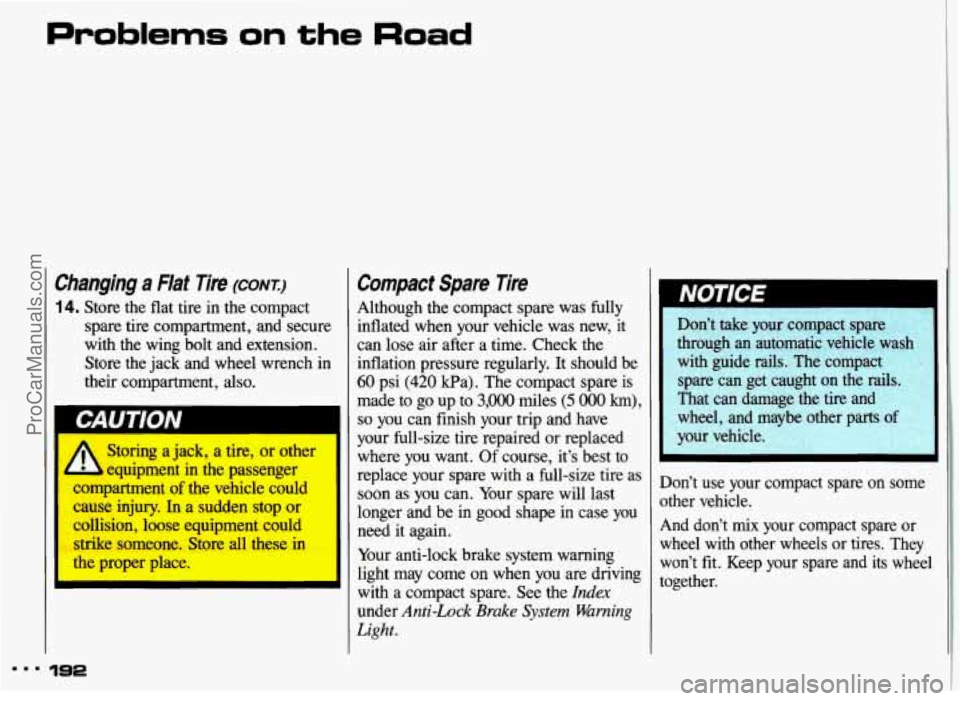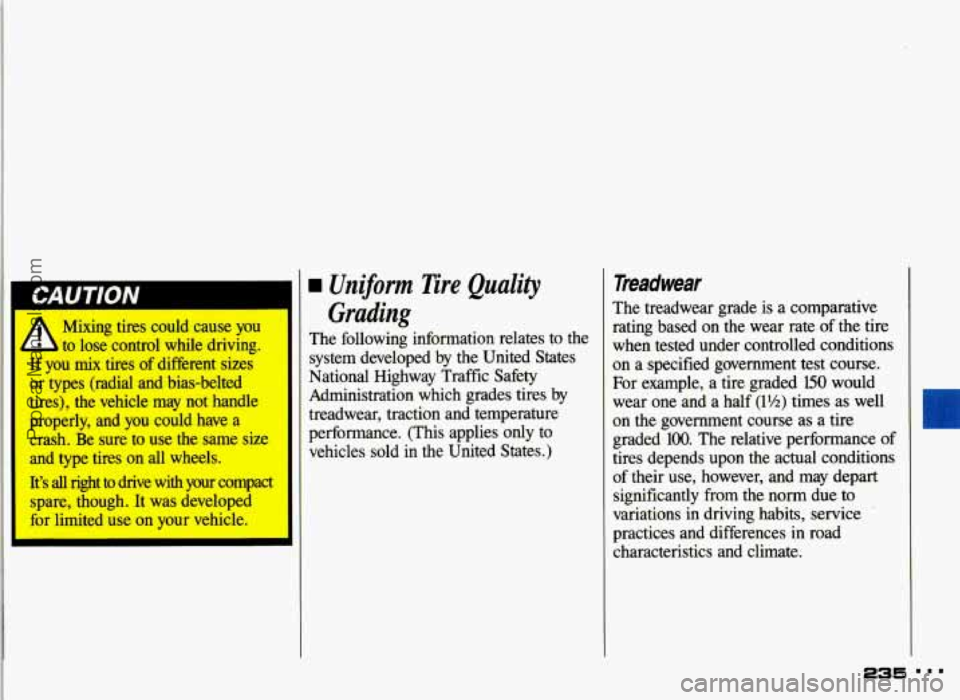Page 191 of 306
Problems on the Road
F"
'hanging a Flat Tire (CONT.)
f A Rust or dirt on the wheel, or
L on the parts to which it is
fastened, can make the wheel nuts
become loose after a time, The
wheel could come off and cause an
accident. When you change a
wheel, remove any rust or dirt
from the places where the wheel
attaches to the vehicle. In an
emergency, you can use a cloth or
a paper towel to do this; but be
sure to use a scraper or wire brush
later, if you need to, to get all the
rust or dirt off.
9. Remove any rust or dirt from the
wheel bolts, mounting surfaces or
spare wheel.
mounting surface.
10. Place the spare on the wheel
Never use oil or grease on
e b studs or nuts. If you do, the
nuts might come loose. Your wheel
could fall off, causing a serious
accident.
I
1 1. Replace the wheel nuts with the
rounded end of the nuts toward the
wheel. Tighten each
nut by hand
until the wheel is held against the
hub
..I 190
ProCarManuals.com
Page 192 of 306
12. Lower the vehicle by rotating the
wheel wrench counterclockwise.
Lower the jack completely. 13. Tighten the wheel nuts firmly in a
criss-cross sequence, as shown.
Incorrect wheel nuts or
- mproperly tightened wheel
nuts can cause the wheel to
become loose and even come
off.
This could lead to an accident. Be
sure to use the correct wheel nuts.
If
you have to replace them, be
sure to get the right kind.
Stop somewhere as soon as
you
can and have the nuts tightened
with a torque wrench
to
100 pound-feet (140 Nom). Don't
try to put a wheel cover on your
compact spare tire.
It won't fit. Store the
wheel cover and plastic cap nuts in the
trunk until you have the flat tire repaired
or replaced.
NOTICE
IS1
ProCarManuals.com
Page 193 of 306

Changing a Flat Tire (corvr)
14. Store the flat tire in the compact
spare
tire compartment, and secure
with the
wing bolt and extension.
Store the jack and wheel wrench in
their compartment, also.
I A Storing a jack, a tire, or other
- equipment in the passenger
ompartment
of the vehicle could I
cause injury. In a sudden stop or
collision, loose equipment could strike someone. Store all these in
the proper place.
i
Compact Spare Tire
Although the compact spare was fully
inflated when your vehicle was new, it can lose air after a time. Check the
inflation pressure regularly. It should be
60 psi (420 Wa). The compact spare is
made to go up to
3,000 miles (5 O00 km),
so you can finish your trip and have
your full-size tire repaired or replaced
where you want.
Of course, it’s best to
replace your spare with a full-size tire as
soon
as you can. Your spare will last
longer and be in good shape
in case you
need it again.
Your anti-lock brake system warning
light may come on when you are driving
with a compact spare. See the
Idex
under Anti-Lock Brake System Warning
Light.
192
Don’t take your compact spare
through
an automatic vehicle wash I
with guide rails. The compact spare can get caught on the rails.
That can damage the tire and
wheel, and maybe other parts
of
your vehicle.
)on? use your compact spare on some
)ther vehicle.
ind don’t
mix your compact spare or
vheel with other wheels or tires. They
von’t
fit. Keep your spare and its wheel
ogether.
ProCarManuals.com
Page 194 of 306
-
Tire chains won’t fit your compact
spare. Using them will damage
your vehicle and destroy the chains
too. Don’t use tire chains
on your
compact spare.
A Storing a jack, a tire, or other
- equipment in the passenger
compartment
of the vehicle could
cause injury.
In a sudden stop or
collision, loose equipment could
strike someone. Store
all these in
the proper place.
If You’re Stuck: In Sand, Mud,
Ice or Snow
What you don’t want to do when your
vehicle is stuck is to spin your wheels.
The method known as “rocking” can
help
you get out when you’re stuck, but
you must use caution.
CAUTION I
A
If you let your tires spin at high
speed, they can explode and you
or others could be injured.
And,
the transaxle or other parts of the
vehicle can overheat. That could
cause an engine compartment fire
or other damage. When you’re
stuck, spin the.wheels as little as
possible. Don’t spin the wheels
above
35 mph (56 km/h) as shown
on the speedometer.
193
ProCarManuals.com
Page 195 of 306
Problems on the Road
If Mu’re Stuck: In Sand, Mud,
Ice or Snow (CONXI
Spinning your wheels can dest
parts
of your vehicle as well as
tires.
If you spin the wheels too
fast while shifting your transaxle
back and forth,
your transaxle.
__
OY
194
Rocking Your Vehicle to Get it Out:
First, turn your steering wheel left and
right. That will clear the area around
your front wheels. Then shift back and
forth between
R (Reverse) and a
forward gear, or with a manual
transaxle, between
1 or 2 and R (Reverse),
spinning the wheels as little as possible.
Release the accelerator pedal while you
shift, and press lightly on the
accelerator pedal when the transaxle is
in gear. If that doesn’t get you out after a
few tries, you may need to be towed out.
If you do need to be towed out, see the
Index under Towing Your Pontiac.
ProCarManuals.com
Page 234 of 306
When to Check:
Check your tires once a month or more.
Don’t forget your compact spare tire. It
should be at
60 psi (420 kPa).
How to Check:
Use a good quality pocket-type gage to
check tire pressure. Simply looking at
the tires will not tell you the pressure,
especially if you have radial tires-
which may look properly inflated even if
they’re underinflated.
If your tires have valve caps, be sure to
put them back on. They help prevent
leaks by keeping out dirt and moisture.
lire inspection and Rotation
To make your tires last longer, have
them inspected and rotated at the
mileages recommended
in the Mainte-
nance Schedule. See the
Index under
Scheduled Maintenance Sewices .
Use this rotation pattern.
After the tires have been rotated, adjust
the front and rear inflation pressure as
shown
on the Tire-Loading Infomation
label. Make certain that all wheel
nuts
are properly tightened. See the Index
under Wheel Nut Torque.
233 .
ProCarManuals.com
Page 235 of 306

Service & Appearance Care
Tire Inspection and Rotation
(CONT)
1 Rust or dirt on a wheel, or on
- b the. parts to which it is
htened, ean fnake wheel nuts I
become loose after a time, The
wheel could come off and cause an I accident. When you change a
wheel, remove any rust or dirt
from plks where the wheel
When lt’s Time for New Tires
One way to tell when it’s time for new
tires is to check the treadwear
indicators, which will appear when your
tires have only
2/32 inch (1.6 mm) or
less of tread remaining.
You need a new tire if:
You can see the indicators at three
You can see cord or fabric showing
The tread or sidewall is cracked. cut.
places around the tire.
through the tire’s rubber.
attaches to the vehicle. ~n an 7 -
emergency, you can use a cloth or I I or snagged deep enough to show cord
a ppr towel ta do this; but be or fabric.
sure t.a use a scraper or wire brush The tire has a bump, bulge or split.
later, if you need to, to get all the The tire has a puncture, cut, or other
rust or dirt off, (See the Index damage that can’t be repaired well
undkr hgiing a 2?i?af Ere.) because of the size or location of the
I damage.
... 234
Buying New Tires
To find out what kind and size of tires
you need, look at the Tire-Loading
Information label.
The tires installed on your vehicle when
it was new had a Tire Performance
Criteria Specification (TPC Spec)
number on each tire’s sidewall. When
you get new tires, get ones with that
same TPC Spec number. That way, your
vehicle will continue to have tires that
are designed to give proper endurance,
handling, speed rating, traction, ride and other things during normal service
on your vehicle.
If your tires have an all-
season tread design, the TPC number
will be followed by a
“MS” (for mud
and snow).
If you ever replace your tires with those
not having a TPC Spec number, make
sure they are the same size, load range,
speed rating and construction type (bias,
bias-belted
or radial) as your original
I tires.
ProCarManuals.com
Page 236 of 306

CAUTION
A
Mixing tires could cause you
to lose control while driving.
If you mix tires of different sizes
or types (radial and bias-belted
tires), the vehicle may not handle
properly, and you could have a
crash. Be sure to use the same size
and type tires on all wheels.
It's
all right to drive with your compact
spare, though. It was developed
for limited use
on your vehicle.
I
Grding
The following information relates to the
system developed by the United States
National Highway Traffic Safety
Administration which grades tires by
treadwear, traction and temperature
performance. (This applies only to vehicles sold in the United States.)
Treadwear
The treadwear grade is a comparative
rating based on the wear rate of the tire
when tested under controlled conditions
on a specified government test course.
For example, a tire graded
150 would
wear one and a half
(1%) times as well
on the government course as a tire
graded
100. The relative performance of
tires depends upon the actual conditions of their use, however, and may depart
significantly from the norm due to
variations in driving habits, service
practices and differences in road
characteristics and climate.
235 " '
ProCarManuals.com